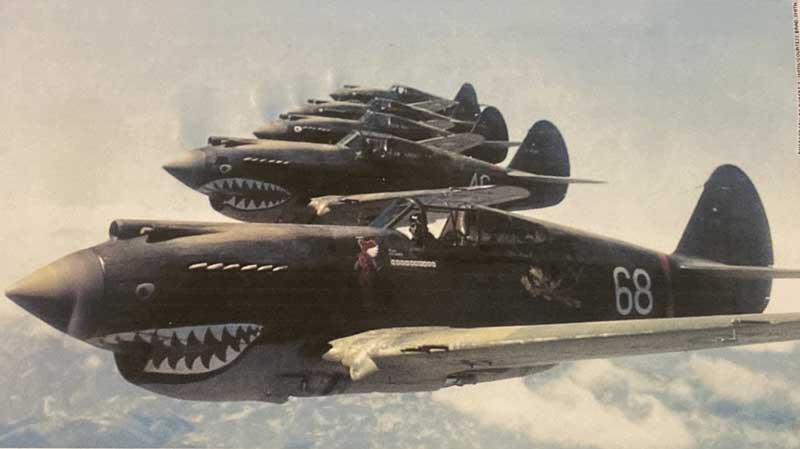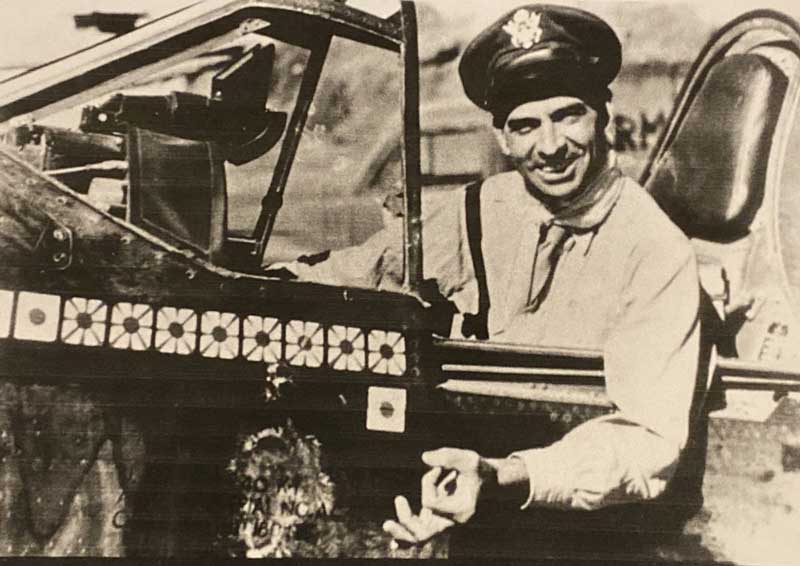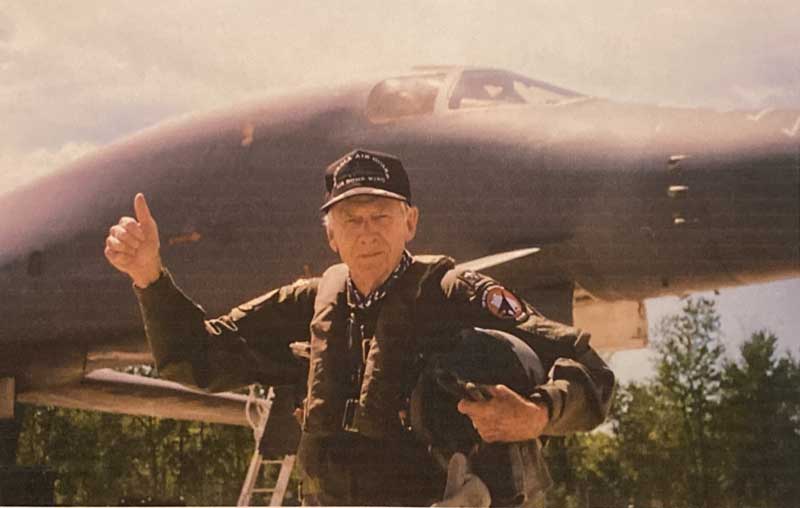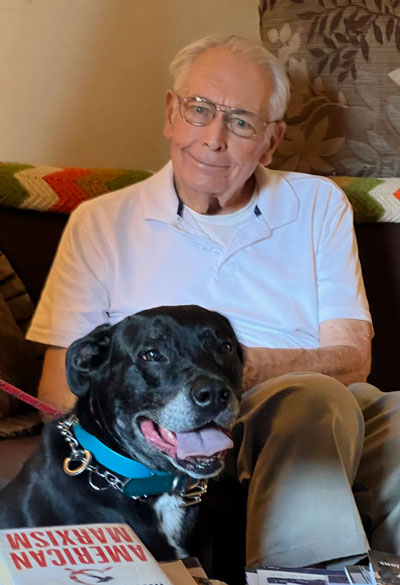
“In the summer of 1941, months before America was drawn into WW11…, a small group of American military pilots was secretly being recruited to augment China’s Air Force. At the head of this effort was a crusty, retired WW1 Army Air Corps fighter pilot (the partially deaf Claire Chennault) who had been hired by China to strengthen the Chinese Air Force. Because America was not at war with Japan, great care was taken to avoid bringing into question this nation’s neutrality. As a result, these volunteer pilots were required to resign their commissions with the U.S. military, travel to China as civilians and enlist in the Chinese Air Force. These roughly 100 pilots and 200 support crew were … known as “The First American Volunteer Group” or AVG. After their first combat on Dec. 18, 1941, where they were highly outnumbered and very successful, a journalist wrote in his column, ‘They flew like tigers….’ From that time on, they became known as ‘The Flying Tigers’. (With a tiger shark’s mouth & teeth painted on the front of their Curtiss P-40 Warhawks.) The Flying Tigers were disbanded and replaced by the U.S. military 7 months later on July 4, 1942, but during (those 7 months), they racked up one of the finest air combat records in history.” (Quoted from Flying Tiger pilot R.T. Smith (1918-1995) in his “History of the American Volunteer Group, in the on-line blog, “History of the Flying Tigers”.
(I’m indebted to the following sources for information on the late, great Flying Tiger pilot, Robert Lee Scott, Jr. (1908-2006): Wikipedia, and Scott’s obituary published in The New York Times on Feb. 28, 2006, written by Richard Goldstein, from both of which I quote somewhat freely while amplifying the story in my own words.)
Robert Lee Scott, Jr. retired from the U.S. Air Force in 1957 with the rank of Brigadier General. He was very well known by my generation in the years following WW11 as a member of that very exclusive fraternity known as “The Flying Tigers”, and as the author of his best selling autobiography, God Is My Co-Pilot, published in 1943 (plus 11 other books over his lifetime). Scotty, as he was almost always referred to, was born in 1908 to Robert and Ola Scott, in Waynesboro, Georgia. He completed most of his school years in Macon, Georgia, and became an Eagle Scout. His vast flying career began during his Boy Scout years when he built a large glider in order to earn a merit badge. As he often recounted, he took off in his glider from the sloping roof of a neighbor’s home, but within seconds one of the wings collapsed, and he ended up “crash landing” in a neighbor’s bed of prized roses. As he often quipped, this was the only time he ever crashed during his flying career, during which he logged an INCREDIBLE 33,000 flying hours.
Scotty was graduated from West Point in 1932, and soon thereafter completed his pilot’s training in Texas, at Kelly Field. In the Fall of 1933 he was assigned to Mitchel Field in New York state. He delivered air mail during 1934, then was assigned the command of a fighter pursuit squadron (bi-planes) in Panama, to protect the Canal, and spent most of the rest of the 1930’s as a training instructor for new military pilots in Texas and California. Soon after the Japanese attack on Pearl Harbor, Scotty joined Task Force Aquila, which was assigned the duty of ferrying a group of Boeing B-17 Flying Fortress bombers to the Asian theater of war (China, Burma, India), to participate in a dangerous mission. Always “gung-ho” to get in on the action, he volunteered to join Aquila’s mission, which was to bomb the Japanese mainland from bases in China. He pleaded with his superiors for combat duty, but at age 33 he was deemed “too old” for combat. “Fate” intervened for Scotty, because he apparently was mistaken for another pilot named Scott, and though he had NO experience flying the B-17 bomber, he was selected by Aquila’s organizers to fly one of those Flying Fortresses to Africa, and then on to India. Scotty “learned” to fly that B-17 DURING the ferrying flight to Africa, having “convinced” another pilot to give him some piloting pointers for that legendary aircraft.
Task Force Aquila was to have attacked the Japanese mainland with heavy bombers right after Col. Jimmy Doolittle’s daring raid in April of 1942, but when Scotty arrived in India with his flight of B-17’s, he discovered that the mission had been cancelled. By now a Colonel in the U.S. Army Air Corps, Scotty seethed with impatience to get involved in combat. Instead, he was soon made Executive & Operations Officer of the Assam-Burma-China Ferry Command, the forerunner of the famous Air Transport Command that flew the dangerous “Hump” over the Himalayan mountains from India to China to supply the Chinese Nationalist government in its fight against the Japanese.
Eventually, Robert Scott came to the attention of Gen. Claire Chennault, who was commanding the AVG (American Volunteer Group) in China, a group which was technically a part of the Chinese Air Force, but which was by then known as The Flying Tigers. Scotty was still determined to become a combat pilot and told Gen. Chennault that he wanted to learn the tactics employed by The Flying Tigers. Chennault gave Scotty the use of a Republic P-43 fighter, in which he flew at least one very high altitude mission over Mount Everest. Soon Chennault allowed Scotty to fly missions WITH the Flying Tigers, wherein he sometimes flew a SOLO P-40 Warhawk as a one plane escort for the transport aircraft, and also bombed and strafed Japanese supply columns on the ground. During these times, he often repainted the propeller spinner of his P-40 in different colors to give the illusion that a much larger fighter force was operating in the area, and became basically a one-man air force!

On July 4, 1942 The AVG—The Flying Tigers—were incorporated into the 23rd Fighter Group, newly formed by Gen. Chennault. At the personal request of Generalissimo Chiang Kai-shek, head of the Chinese Nationalist government, Robert Scott was named commander of that new group. Most, but not all, of the former “Flying Tigers” voluntarily became inducted into the U.S. Air Corps. (The 23rd Fighter Group was eventually incorporated into the 14th Air Force.) Scotty got his wish to fly combat missions -- he flew 388 of them, over 925 hours from July, 1942 until October, 1943, and shot down at least 13 Japanese aircraft (with probably more unconfirmed kills), to become one of America’s earliest flying “aces” of WW11.
In October, 1943 Scotty was ordered back to the U.S. to become Deputy for Operations at the Army Air Force School of Applied Tactics in Orlando, Florida. During a nationwide tour of war materiel factories at this time, he was asked by Scribner Publishers to write down his experiences for a book they would publish. His recollections eventually became the famous book, “God Is My Co-Pilot”, which was published in late 1943 and received fabulous reviews. (A popular film of that same name, starring Dennis Morgan as Scott, was released in February, 1945 and received wide acclaim). In his introduction, Col. Scott recounted how he had chosen the title for his book. He explained that he was returning to his Chinese base in a P-40 when an explosive bullet fired from a Japanese fighter hit the armor behind his cockpit seat, which sent several rivet heads into his back.
After landing, and in his base’s bunker, he was attended by Dr. Fred Manget, a medical missionary who “patched him up”. A Chinese orderly asked Scotty how he could fly his plane, drop bombs on the enemy, and fire his guns with no one to help him. As Col. Scott wrote: “I heard the old doctor say, ‘No, son, you’re not up there alone. Not with all the things you came through. You have the greatest co-pilot in the world even if there is just room for one in that fighter ship. No, you’re not alone’” Scotty said that as soon as he heard those words, he experienced a “vision”: Blazing lights in the bunker spelling out the words—“God is my co-pilot”!
Brigadier General Robert Lee Scott was quite a man—quite a patriot. He commanded several Air Force Schools, Fighter-Bomber Wings, and Luke Air Force Base in Arizona before he retired. His wife, Catherine, passed in 1972, and in the 1980’s he moved to Warner Robins, Georgia, working for many years as the honorary chairman of The Museum of Aviation at Warner Robins Air Force Base. In 1980 he accomplished one of his life’s goals: Receiving permission from the Chinese Government and hiking the entire 1900 mile length of The Great Wall of China in 94 days, at age 72.

Scotty logged his final flight on his 89th birthday, in 1997, when he flew as an “honorary” crewman on a B-1B Lancer bomber, having previously piloted an F-16 Falcon Jet fighter in 1984 (at age 76) and an F-15 Eagle Jet fighter in 1995 (at age 87). I don’t know if Scotty was a Christian, but he surely was an American hero. We need a whole lot more, of BOTH!
++++++++++++++++++++
After I finished writing this article I discovered that General Robert Lee Scott had included one of my favorite poems in his book, God Is My Co-Pilot, which I had read some 65 years ago and had forgotten that Scott loved this poem and had included it in his most famous book, and which has become beloved by the American people since it was written in 1941. President Ronald Reagan used a portion of it during his 1988 tribute to the victims of the Shuttle Challenger disaster, and I wept while listening to him.
The poem is a sonnet, written by John Gillespie Magee (1922-1941) titled HIGH FLIGHT. Magee was born in Shanghai, China, the son of an American missionary (John Magee Sr.) and an English mother, and grew up mostly in England, which he considered his native country. Magee Sr. later became a pastor in the Anglican Church. The young Magee was sent to the U.S. by his parents in 1939 to complete his high school studies, but yearned to return to England. In 1940, at age 18, he enlisted in the Royal Canadian Air Force and received his training as a “Spitfire” fighter pilot, and was eventually sent to England to fly with The Royal Air Force. On December 11, 1941, at age 19, he was killed in a tragic mid-air collision with an inexperienced pilot during a training flight, and is buried in his beloved England. At his death he was a “Pilot Officer” in No. 412 Squadron of the RCAF. He wrote many poems in his few years, of which “High Flight” is probably his best known. He wrote it on the same day that he flew his Supermarine Spitfire to an altitude of 30,000 feet, which not many pilots had done in Spitfires, and it is thought by those who knew him that this is what motivated him to write this beautiful sonnet. Let me share his emotions and words with you:
HIGH FLIGHT
By John Gillespie Magee
Age 19
“Oh! I have slipped the surly bonds of earth And danced the skies on laughter-silvered wings;
Sunward I’ve climbed, and joined the tumbling mirth Of sun-split clouds—and done a hundred things
You have not dreamed of—wheeled and soared and swung High in the sunlit silence. Hov’ring there I’ve chased the shouting wind along, and flung My eager craft through footless halls of air.
Up, up the long delirious, burning blue, I’ve topped the windswept heights with easy grace Where never lark, or even eagle flew—
And, while with silent lifting mind I’ve trod The high untresspassed sanctity of space, PUT OUT MY HAND AND TOUCHED THE FACE OF GOD.”














